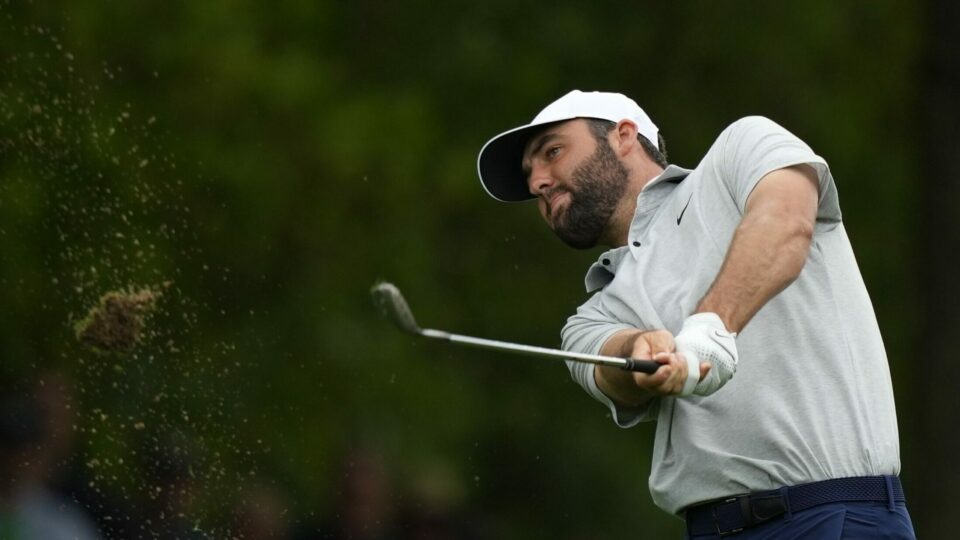AUGUSTA, GA. The process of 72-hole tournaments – especially major championships – is a constant tug-of-war with internal emotions fluctuating constantly.
At different moments you feel the exhilaration of a superb shot. Just seconds later you can quickly feel the situation sliding out-of-control as you free fall because a poorly executed shot places you in a precarious position.
While physical skills are a central element in playing golf it is the even more critical mental side that can keep matters in the proper balance.
In golf, unlike other team sports, there are no teammates to bail you out. There are also no time outs that can be taken. All one has is one’s own wits and hopefully the able-assistance of one’s trusted caddie.
When Saturday’s third round of the 88th Masters started three men were tied for the lead. The best player on the planet – Scottie Scheffler – was one of them.
The 27-year-old was most fortunate to chip in at the 1st after missing the green. Another birdie followed at the short par-4 3rd. But what should have been a spring board of momentum pushing him onward suddenly became a struggle with a number of indifferent shots uncharacteristic of the world’s best player.
An outward side score of 35 was good but should have been lower.
Scheffler started the par-4 10th with a fine tee shot but then hit his 7-iron approach over the flagstick and jumped off the back of the green. Now simply trying to escape with no more than a bogey he chipped long and proceeded to three-putt for double-bogey.
Keep in mind, given Scheffler’s recent play of two wins and a runner-up finish the inclusion of a double-bogey was beyond comprehension.
Scheffler then failed to gather himself and another bogey followed at the long par-4 11th. Where he had been in the lead for nearly all of the tournament this saw him cascade down the leaderboard at -4 and trailing no less than five players.
The free-fall continued when he pulled his approach with his ball jumping the back of the green at the short par-3 12th After getting his ball to eight feet away, a crucial moment had arrived.
When golfers – even elite ones – start to see matters slide away the wherewithal to batten down the hatches and stop the scorecard bleeding presents no small task.
In the 1963 Masters Jack Nicklaus was attempting to win his first green jacket and after holding a solo lead for much of the event he proceeded to drop back near the ending of the final round. Nicklaus righted the ship with a clutch birdie at the par-3 16th and closed out the event with two air-tight pars and his first Augusta victory.
Often when players have the lead for a long period of time and then see it get whittled away the wherewithal to right the ship and regain one’s footing can prove to be an insurmountable task. Ed Sneed and Kenny Perry both saw this happen to them at the 1978 and 2008 Masters.

Getting matters back under control can happen but more often than not when the free fall happens it’s the equivalent of jumping out of an airplane without a parachute. The ending is never pleasant.
Scheffler’s round hinged on that par-putt at the 12th. A bogey would have meant another shot loss and a further sinking of his position in the tournament.
Scheffler gamely fought through and holed the putt.
That save provided a much needed tourniquet to keep the bleeding in check.
The par-5 13th served as the critical boost to get him back to the top of the leaderboard. A fine drive was followed-up by a quality approach. Scheffler faced a 35-foot putt and then holed it for eagle – the first of the day on the hole.
Scheffler took advantage of the second par-5 on the inward half at the 15th and was able to sink an 8-foot-putt for a birdie and the outright lead.
In little over 30 minutes Scheffler had gone from a downward spiral to one where he was back in control.
A three-putt bogey at the penultimate hole was brilliantly follow-ed up by a concluding birdie at the 18th and a one-shot lead over Collin Morikawa. Both men will be paired together for Sunday’s concluding round. Keep in mind, since 2014 – with one exception – the winner of the green jacket has come from the final pairing.
When Bob Jones and Alister MacKenzie created Augusta National the role of the par-5 holes was central in their thinking. Both men saw such holes as opportunities for clear risk/reward situations.
Scheffler seized upon that scoring a total of 7 on both holes. His nearest rivals – Morikawa and Bryson DeChambeau scored a collective total of 10 and 12 respectively.
However, the critical par putt Scheffler holed at the 12th set the stage for such a magnificent turnaround to happen.
Interestingly, Scheffler’s playing partner Nicolai Højgaard had secured the outright lead with a birdie at the 10th and then promptly proceeded to make five consecutive bogies pushing him considerably downward on the leaderboard.

Related: Masters meltdown – tortoises reign supreme
Scheffler is an experienced player and a past Masters champion. That level of experience paid dividends for when things seemed to be going nowhere fast. On the flip side, Højgaard is a 23-year-old Masters rookie and his inability to stem his sinking ship should prove to be a lasting lesson the next time the talented Dane gets into a similar situation.
In the years that followed Jack Nicklaus’ win in 1963 he was quick to keep the lessons learned from that Masters triumph in his memory banks with 16 major wins to come.
Scheffler’s growth as a player was tested at a pivotal moment in Saturday’s third round.
Even with his remarkable turnaround there are still 18 holes to play Sunday. No one needs to tell Scottie green jackets are not awarded for 54 holes but over 72.
Keeping a clear head made all the different for Nicklaus and could well prove to do similarly for the world’s best player.
If a second green jacket happens Sunday, the putt at the 12th will always loom large in Scheffler’s development as the game’s premier player.
